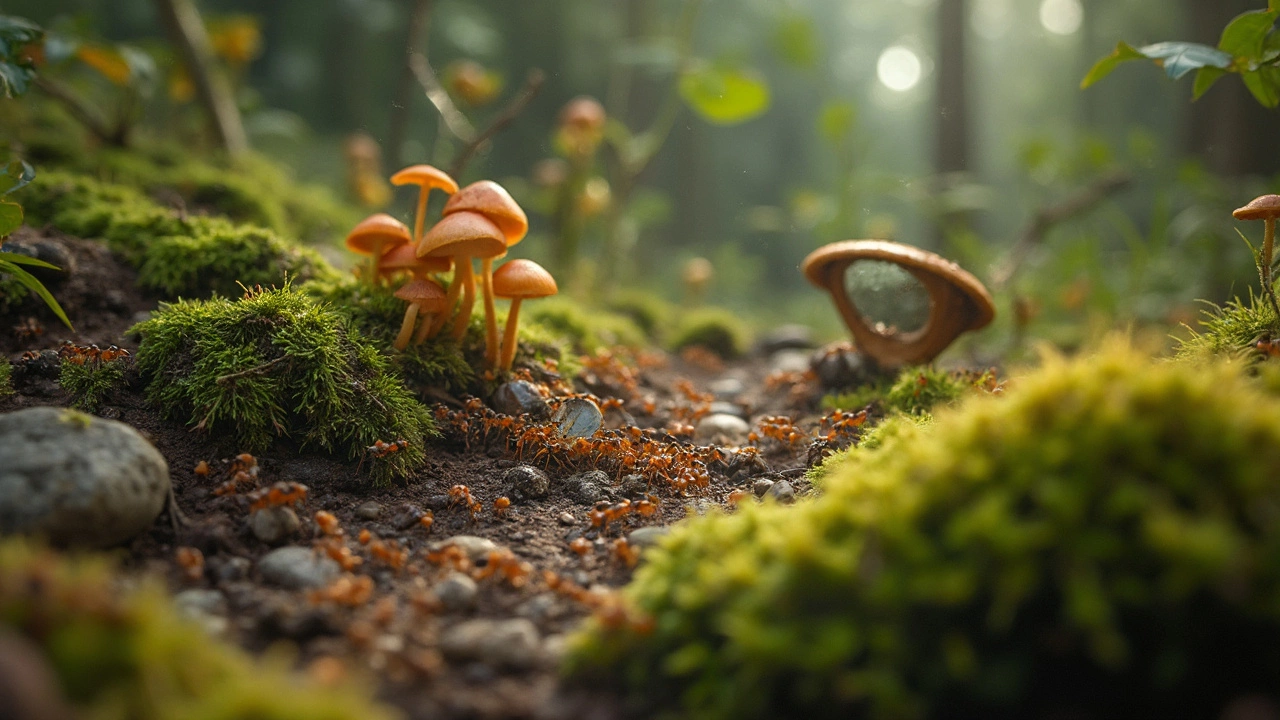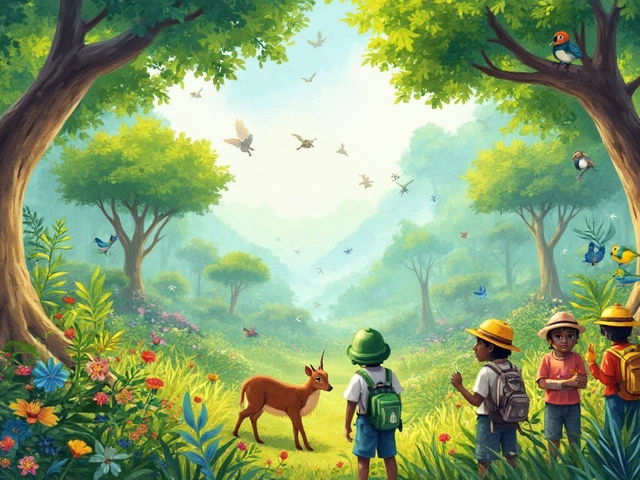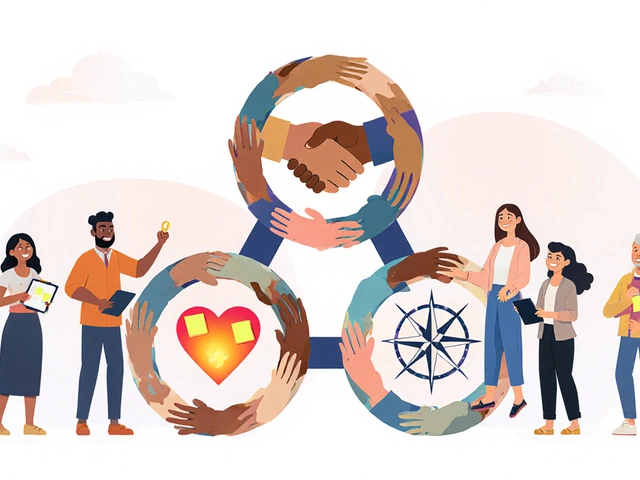Ever noticed how a pond isn’t just water, but a wild mix of frogs, plants, bugs, and maybe even a turtle or two? That’s a community in action—basically, all the living things sharing one space and figuring out how to make it work. In the world of environmental groups, these communities aren’t just a nice idea—they’re the building blocks of every single ecosystem out there.
You might think all communities in nature are pretty much the same, but nope—they come in all sorts of flavors and sizes. Some are packed with huge trees and birds, others with microscopic life you’d never spot unless you were looking under a microscope. Knowing what kinds exist isn’t just trivia; it’s super helpful if you’re into conservation, biology, or just want a reason to look smarter during a nature walk.
- Biotic Communities Explained
- Key Types of Ecosystem Communities
- How Communities Interact and Shape the Ecosystem
- Spotting and Supporting Local Communities
Biotic Communities Explained
Biotic communities are basically groups of living things—plants, animals, fungi, and microbes—all hanging out in the same spot and making up the living side of an ecosystem. Think of them as nature’s neighborhoods, built on who lives there and how they get along. They don’t just share space. They compete for food, help keep each other in check (like wolves and deer), and sometimes even team up, like bees pollinating flowers.
Here’s a cool thing: scientists call every member of these communities a “biota.” So, next time you’re in the backyard and spot birds, ants, and weeds, know you’re looking at a tiny biotic community in action. Different ecosystems have their own unique communities based on what can survive there. You’ll get totally different living groups in a desert than you will in a rainforest or your local pond.
People group biotic communities by what dominates the area. If plants are running the show, it’s called a plant community. Same deal for animal-dominated areas. Usually, though, it’s a wild mix, with tons of interactions that keep everything balanced. If something throws a wrench in the works—like introducing a new species or wiping out a key predator—the entire community can change fast.
- Biotic communities can be huge (like a forest) or tiny (like under a rock).
- They’re always changing, especially if there’s a fire, flood, or even just a bunch of new bugs moving in.
- Microbes might not be visible, but they play a gigantic role—breaking down waste, recycling nutrients, and sometimes making other life possible.
If you want to spot a biotic community up close, visit a pond edge, turn over a log, or even check out your city park lawn. With a little patience, you’ll start to pick out who’s living where, who’s eating what, and how everything’s connected.
Key Types of Ecosystem Communities
Nature groups life into communities, and not all are built alike. Scientists usually divide these into a few main types based on what’s living there and where it happens. The main ones you’ll bump into are plant communities, animal communities, and those where everything mixes together—including super tiny life like bacteria that most folks totally miss.
Ecosystem communities come in a bunch of different forms, but here’s how the big categories usually break down:
- Plant communities: Think forests, grasslands, or even your lawn. These are mostly made up of plants, and the types of plants tell you a lot about that place—like if it’s super wet, really dry, cold, or hot. Forests in the Amazon, for example, have way more plant species than forests up in snowy Canada.
- Animal communities: These are made up of creatures that hang out in the same area—picture a herd of zebras, a school of fish, or a flock of starlings. They often stick together for safety, food, or just to keep life interesting.
- Microbial communities: You can’t see them with your eyes, but these groups—like bacteria in the soil or inside your gut—play giant roles. Healthy soils have tons of different bacteria and fungi working together to break stuff down, build nutrients, and even help plants grow.
- Mixed communities: This is basically the full party—a blend of plants, animals, fungi, and microbes all interacting. This is what you see in places like tidepools, coral reefs, or even a backyard garden.
You’ll spot these communities on every continent, but their setup depends on things like rainfall, temperature, and even what humans get up to nearby. For example, coral reefs only cover less than 1% of the ocean floor but support about 25% of all marine species. Forests, which cover 31% of the world’s land, are home to over 80% of earth’s land-based animals, insects, and plants.
| Community Type | Notable Example | Common Species Count |
|---|---|---|
| Rainforest Plant Community | Amazon Rainforest | 390 billion individual trees |
| Animal Community | Great Wildebeest Migration, Serengeti | 1.5 million wildebeest |
| Microbial Community | Soil in Temperate Forests | Billions in a handful of soil |
| Mixed Community | Great Barrier Reef | 1,500+ fish species |
If you want to support these communities, even small actions count—like planting native flowers (for plant and mixed communities), leaving some wild spots in your yard for bugs, or just learning what’s thriving in your closest park.

How Communities Interact and Shape the Ecosystem
When you dig into how communities work together in an ecosystem, it’s all about connections. Each group—whether it’s giant oak trees, ants, birds, or bacteria—affects the others. Some are neighbors, some are rivals. These messy, on-the-ground relationships shape everything from the air we breathe to the way soil feels under your feet.
Take bees and flowering plants. Bees need nectar, plants need pollinators. It’s a win-win and it keeps both communities afloat. This is what scientists call mutualism. You’ll also see competition—like when two bird species go after the same berries—or even predators and their prey. It's not always pretty, but it keeps things balanced.
Every role counts. Microbes break down dead stuff, recycling nutrients for plants. Plants offer shade, food, and shelter to animals and insects. Animals like earthworms tunnel through soil, making it healthier and easier for roots to grow. Fish communities, for example, change the way lakes cycle nutrients, and that, in turn, affects plants and even the water itself.
Here’s a quick look at some classic interactions you’ll spot in any typical ecosystem:
- Competition: Plants may fight for sunlight and soil nutrients. Animals compete for food, shelter, and space.
- Mutualism: Birds spread seeds after snacking on fruit, helping plants spread out.
- Predation: Owls eat mice, keeping rodent numbers in check.
- Commensalism: Remoras hitch a ride on sharks, getting free transportation and leftover snacks, while the shark doesn’t mind.
Healthy ecosystems rely on this network of checks and balances. When one piece gets thrown off—like heavy logging wiping out too many trees—it can ripple through the community and throw the whole place out of whack. Want proof? Look at Yellowstone Park: when wolves were brought back after decades, everything shifted. Elk numbers dropped, plants bounced back, and even rivers changed course because the land wasn’t getting trampled as much.
Scientists often use numbers to figure out how these interactions play out. Here’s a snapshot of a real grassland ecosystem and what happens when one community member disappears:
| Species Removed | Resulting Impact | Change in Plant Cover (%) |
|---|---|---|
| Prairie Dog | Less soil turning, fewer plant species | -24 |
| Top Predator (Coyote) | Increase in rodents, more plant damage | -15 |
So, if you want to keep an ecosystem healthy, protecting all the different ecosystem communities really does matter. Every single one shapes the world in ways you’ll see—and lots you won’t.
Spotting and Supporting Local Communities
Getting to know the different communities in your own backyard isn’t rocket science—it just takes paying attention to what’s living around you. Walk through a park, and you’ll usually spot plant groups, like patches of wildflowers or clusters of certain trees. Check out who hangs around—bees buzzing, birds singing, squirrels darting through branches. That’s nature’s version of a neighborhood, all sharing the same food, space, and even water sources. If you’re near water, pause and see what’s happening along the edge. Frogs, dragonflies, and all sorts of small critters thrive where land and water meet.
Want to go deeper? Grab your phone or a notebook and start making lists. Jot down every type of critter or plant you come across—even the tiny stuff under rocks or in leaf piles. There are handy apps like iNaturalist or Seek that help you identify species and show if they’re common, rare, or even endangered in your area. By tracking what you see, you’re actually helping scientists know more about local ecosystem health.
If you’re thinking about how to support your local communities, there’s a lot you can do without much effort. Here’s what actually makes a difference:
- Keep native plants in your yard or on your balcony—these are the ones local insects and birds rely on for food and shelter.
- Skip pesticides or harsh chemicals. They disrupt insect and microbe populations, which are a huge part of every healthy community.
- Leave some areas a bit messy—piles of leaves, logs, and rocks are prime spots for beetles, fungi, and tiny frogs.
- Join a local clean-up or habitat restoration project. These events don’t just help the land; they connect you to other people passionate about the same thing.
- Share your observations with local nature groups or online communities. The more folks know what’s out there, the more likely those spaces get the support they need.
One cool tip: in cities like Chicago and Singapore, community-led garden projects have brought back butterflies and bees that vanished for years. Small actions—planting one milkweed or picking up some trash—can kickstart big changes in your local area. Every step adds up, and sometimes your own street can become a hotspot for urban wildlife.








